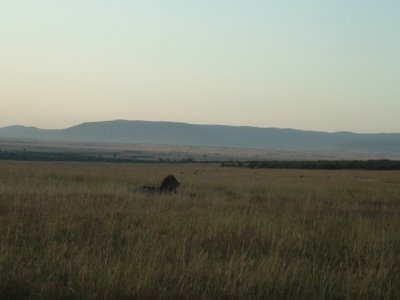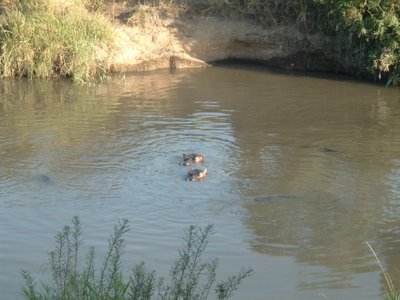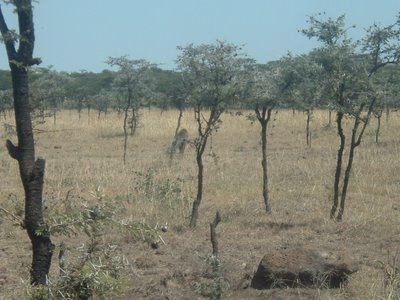
As predicted, the trip to Maasai Mara has once again generated a substantial backlog of pictures, anecdotes, and profound earth-shattering insights about the creation and operation of social and political institutions. Okay, so maybe the last bit is a great big fib, but I definitely have plenty of the first two. In the interest of getting the ball rolling, I’m going to throw some of the most choice photos out there, and will update with more thoughts and impressions as I go along. Because lets be honest, even though you find my experiences and stories interesting, the awesome pictures of cute and exotic animals and gorgeous landscapes are what keep you coming back, right?

And what animals there were! In the space of two days I saw three lions, 10 or so elephants, a bunch of hippos, a troop of baboons, some cape buffalo, a family of warthogs, and more gazelles, antelope, and other deer-like horned mammals than I could possibly count. The best thing about getting to see all of these animals is that it was under the auspices of “research”. As I’ve mentioned, I’m working with David Nkedanyie, an ILRI graduate fellow who is writing his PhD dissertation on the drought-coping strategies of Maasai pastoralists. Specifically, he’s interested in understanding what might influence decisions of families to take their cattle across National Wildlife Reserve boundaries during droughts.
 National parks are often replete with good forage during droughts (because they are grazed only by game, rather than by large herds), but it is illegal for herders to take their cattle across these lines. David is trying to get a sense of the empirical incidence of this behavior and what social, economic, and environmental factors may influence the risk calculations of families by doing household surveys in 4 communities that border national parks; Kitengela, which borders Nairobi National Park, Narok District, which borders Maasai Mara, communities around Amboseli National Park, and one of Tanzania’s national parks (clearly, I know more about the ones I’ve visited. Expect more detail on these last two as time goes on).
National parks are often replete with good forage during droughts (because they are grazed only by game, rather than by large herds), but it is illegal for herders to take their cattle across these lines. David is trying to get a sense of the empirical incidence of this behavior and what social, economic, and environmental factors may influence the risk calculations of families by doing household surveys in 4 communities that border national parks; Kitengela, which borders Nairobi National Park, Narok District, which borders Maasai Mara, communities around Amboseli National Park, and one of Tanzania’s national parks (clearly, I know more about the ones I’ve visited. Expect more detail on these last two as time goes on). Normally doing household surveys in four communities this far apart in a country with poor roads and low population density would be extremely impractical. What is allowing David to proceed with this research design is that ILRI already has established projects in each of these field sites, with local community facilitators in each who are in charge of both helping ILRI organize research on the ground, as well as disseminating the results of this research to the local communities. David is one of these community facilitators for Kitengela; through this project (which is in its 4th year), he’s developed a good enough relationship with the community facilitators that they’re willing to help him recruit and train survey enumerators from the local community.
The purpose of our trip was to meet and train the survey enumerators that Dickson, the ILRI community facilitator for the area around Maasai Mara, had recruited.
 My role in the whole operation was as “survey monkey”, helping with the selection of the random sample (stratified by group ranch), stapling questionnaires, and assisting with other various and sundry errands and logistical things that popped up. What was cool about this is that in exchange for this relatively small bit of work, I was able to gain a free, firsthand look at how a small scale field survey is run- what the questionnaire looks like, how to get a good, reliable list of the population you want to survey (the sample frame in technical jargon), and what constitutes a good, reliable, enumerator.
My role in the whole operation was as “survey monkey”, helping with the selection of the random sample (stratified by group ranch), stapling questionnaires, and assisting with other various and sundry errands and logistical things that popped up. What was cool about this is that in exchange for this relatively small bit of work, I was able to gain a free, firsthand look at how a small scale field survey is run- what the questionnaire looks like, how to get a good, reliable list of the population you want to survey (the sample frame in technical jargon), and what constitutes a good, reliable, enumerator. And as a free bonus, Dickson took me and David on a animal-watching drive at daybreak on Friday morning. What is great about this arrangement is that before working for ILRI, Dickson had worked for the Mara Wildlife conservancy, meaning that he knows the park and its resident species like the back of his hand, allowing us to see more animals in a short drive than some tourists see in whole trips. Here are some of the highlights that were tough enough to photograph that they could benefit from a little extra narration.

When we stopped to look at the Talek river, one of the main water sources that runs through the park (the other being the eponymous Mara River), we were lucky enough to spot a big group of hippos. Unfortunately, they spend most of their time submerged, so they're kind of tough to photograph. At the same time, if you can see more of them than their eyes, you probably don't want to be close enough to photograph them. I was however, very very tempted to get a bunch of volleyballs and stage a real life recreation of "hungry hungry hippos". How internet famous would I be if I could pull that off?

This one's a bit tough to see, but if you look at the big fur ball by the one tree, you'll see that its a baboon. Unfortunately we didn't get to chill and watch them a bit. We actually saw this troop once we had left the park and were driving back towards one of the neighboring communities- I snapped this picture on the move, and didn't realize anything had come out until I was loading the pictures into my computer. At the same time, I'm pretty glad that I wasn't too close to these guys: I've heard that "tourist baboons" that have gotten pretty comfortable with humans (as these guys probably have) are pretty obnoxious in terms of stealing food and such. Still, that didn't stop me from pointing and going "MOOOONKEYS!!!!" as we zoomed by.

You might be able to tell that these two grey blobs are elephants browsing from the tops of some trees. This was right across the Talek river from our campsite at sunset. I was limited by both the fading light and the fact that you really don't want to get too close to these guys, so I was only really able to watch them and go "OH MAN THAT IS AWESOME. OH MAN. OH MAN."
Stay tuned for even more images from the game drive and a comparison of the communities I visited there with Kitengela…
2 comments:
look at those hippos in the water. they are definitely out' the game.
one more thing. check this out:
http://www.theonion.com/content/node/49429
Post a Comment